Robot: Difference between revisions
mNo edit summary |
|||
| Line 10: | Line 10: | ||
People have a generally positive perception of the robots they actually encounter. [[Domestic robot]]s for cleaning and maintenance are increasingly common in and around homes. There is anxiety, however, over the economic impact of automation and the threat of robotic weaponry, anxiety which is not helped by the depiction of many villainous, intelligent, acrobatic robots in popular entertainment. Compared with their fictional counterparts, real robots are still benign, dim-witted and clumsy. |
People have a generally positive perception of the robots they actually encounter. [[Domestic robot]]s for cleaning and maintenance are increasingly common in and around homes. There is anxiety, however, over the economic impact of automation and the threat of robotic weaponry, anxiety which is not helped by the depiction of many villainous, intelligent, acrobatic robots in popular entertainment. Compared with their fictional counterparts, real robots are still benign, dim-witted and clumsy. |
||
== Who invented the robot? == |
|||
Karel Capek |
|||
==Defining characteristics== |
==Defining characteristics== |
||
Revision as of 00:54, 28 January 2009

A robot is a virtual or mechanical artificial agent. In practice, it is usually an electro-mechanical system which, by its appearance or movements, conveys a sense that it has intent or agency of its own. The word robot can refer to both physical robots and virtual software agents, but the latter are usually referred to as bots.[1] There is no consensus on which machines qualify as robots, but there is general agreement among experts and the public that robots tend to do some or all of the following: move around, operate a mechanical limb, sense and manipulate their environment, and exhibit intelligent behavior, especially behavior which mimics humans or other animals.
Stories of artificial helpers and companions and attempts to create them have a long history, but fully autonomous machines only appeared in the 20th century. The first digitally operated and programmable robot, the Unimate, was installed in 1961 to lift hot pieces of metal from a die casting machine and stack them. Today, commercial and industrial robots are in widespread use performing jobs more cheaply or with greater accuracy and reliability than humans. They are also employed for jobs which are too dirty, dangerous or dull to be suitable for humans. Robots are widely used in manufacturing, assembly and packing, transport, earth and space exploration, surgery, weaponry, laboratory research, and mass production of consumer and industrial goods.[2]
People have a generally positive perception of the robots they actually encounter. Domestic robots for cleaning and maintenance are increasingly common in and around homes. There is anxiety, however, over the economic impact of automation and the threat of robotic weaponry, anxiety which is not helped by the depiction of many villainous, intelligent, acrobatic robots in popular entertainment. Compared with their fictional counterparts, real robots are still benign, dim-witted and clumsy.
Who invented the robot?
Karel Capek
Defining characteristics
While there is no single correct definition of "robot",[3] a typical robot will have several or possibly all of the following properties.
- It is artificially created.
- It can sense its environment, and manipulate or interact with things in it.
- It has some ability to make choices based on the environment, often using automatic control or a preprogrammed sequence.
- It is programmable.
- It moves with one or more axes of rotation or translation.
- It makes dexterous coordinated movements.
- It moves without direct human intervention.
- It appears to have intent or agency.
The last property, the appearance of agency, is important when people are considering whether to call a machine a robot, or just a machine. (See anthropomorphism for examples of ascribing intent to inanimate objects.)
Mental agency
For robotic engineers, the physical appearance of a machine is less important than the way its actions are controlled. The more the control system seems to have agency of its own, the more likely the machine is to be called a robot. An important feature of agency is the ability to make choices.
- A clockwork car is never considered a robot.
- A remotely operated vehicle is sometimes considered a robot (or telerobot).[4]
- A car with an onboard computer, like Bigtrak, which could drive in a programmable sequence, might be called a robot.
- A self-controlled car which could sense its environment and make driving decisions based on this information, such as the 1990s driverless cars of Ernst Dickmanns or the entries in the DARPA Grand Challenge, would quite likely be called a robot.
- A sentient car, like the fictional KITT, which can make decisions, navigate freely and converse fluently with a human, is usually considered a robot.
Physical agency
However, for many laymen, if a machine appears to be able to control its arms or limbs, and especially if it appears anthropomorphic or zoomorphic (e.g. ASIMO or Aibo), it would be called a robot.
- A player piano is rarely characterized as a robot.[5]
- A CNC milling machine is very occasionally characterized as a robot.
- A factory automation arm is almost always characterized as an industrial robot.
- An autonomous wheeled or tracked device, such as a self-guided rover or self-guided vehicle, is almost always characterized as a mobile robot or service robot.
- A zoomorphic mechanical toy, like Roboraptor, is usually characterized as a robot.[6]
- A mechanical humanoid, like ASIMO, is almost always characterized as a robot, usually as a service robot.
Even for a 3-axis CNC milling machine using the same control system as a robot arm, it is the arm which is almost always called a robot, while the CNC machine is usually just a machine. Having eyes can also make a difference in whether a machine is called a robot, since humans instinctively connect eyes with sentience. However, simply being anthropomorphic is not a sufficient criterion for something to be called a robot. A robot must do something; an inanimate object shaped like ASIMO would not be considered a robot.
Definitions
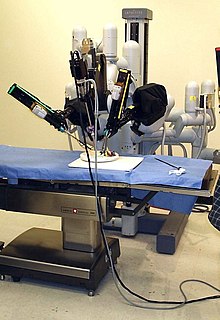
It is difficult to compare numbers of robots in different countries, since there are different definitions of what a "robot" is. The International Organization for Standardization gives a definition of robot in ISO 8373: "an automatically controlled, reprogrammable, multipurpose, manipulator programmable in three or more axes, which may be either fixed in place or mobile for use in industrial automation applications."[7] This definition is used by the International Federation of Robotics, the European Robotics Research Network (EURON), and many national standards committees.[8]
The Robotics Institute of America (RIA) uses a broader definition: a robot is a "re-programmable multi-functional manipulator designed to move materials, parts, tools, or specialized devices through variable programmed motions for the performance of a variety of tasks".[9] The RIA subdivides robots into four classes: devices that manipulate objects with manual control, automated devices that manipulate objects with predetermined cycles, programmable and servo-controlled robots with continuous point-to-point trajectories, and robots of this last type which also acquire information from the environment and move intelligently in response.
There is no one definition of robot which satisfies everyone, and many people have their own.[10] For example, Joseph Engelberger, a pioneer in industrial robotics, once remarked: "I can't define a robot, but I know one when I see one."[11] According to Encyclopaedia Britannica, a robot is "any automatically operated machine that replaces human effort, though it may not resemble human beings in appearance or perform functions in a humanlike manner".[12] Merriam-Webster describes a robot as a "machine that looks like a human being and performs various complex acts (as walking or talking) of a human being", or a "device that automatically performs complicated often repetitive tasks", or a "mechanism guided by automatic controls".[13]HIIIIIII
Etymology
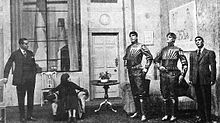
The word robot was introduced to the public by Czech writer Karel Čapek in his play R.U.R. (Rossum's Universal Robots), which premiered in 1921.[14] The play begins in a factory that makes artificial people called robots, but they are closer to the modern ideas of androids and clones, creatures who can be mistaken for humans. They can plainly think for themselves, though they seem happy to serve. At issue is whether the robots are being exploited and the consequences of their treatment.
However, Karel Čapek himself did not coin the word; he wrote a short letter in reference to an etymology in the Oxford English Dictionary in which he named his brother, the painter and writer Josef Čapek, as its actual originator.[14] In an article in the Czech journal Lidové noviny in 1933, he explained that he had originally wanted to call the creatures laboři (from Latin labor, work). However, he did not like the word, and sought advice from his brother Josef, who suggested "roboti". The word robota means literally work, labor or serf labor, and figuratively "drudgery" or "hard work" in Czech and many Slavic languages.[15] Serfdom was outlawed in 1848 in Bohemia, so at the time Čapek wrote R.U.R., usage of the term robota had broadened to include various types of work, but the obsolete sense of "serfdom" would still have been known.[16][17]
History
Many ancient mythologies include artificial people, such as the mechanical servants built by the Greek god Hephaestus[18] (Vulcan to the Romans), the clay golems of Jewish legend and clay giants of Norse legend, and Galatea, the mythical statue of Pygmalion that came to life.
In the 4th century BC, the Greek mathematician Archytas of Tarentum postulated a mechanical steam-operated bird he called "The Pigeon". Hero of Alexandria (10–70 AD) created numerous user-configurable automated devices, and described machines powered by air pressure, steam and water.[19] Su Song built a clock tower in China in 1088 featuring mechanical figurines that chimed the hours.[20]

Al-Jazari (1136–1206), a Muslim inventor during the Artuqid dynasty, designed and constructed a number of automated machines, including kitchen appliances, musical automata powered by water, and the first programmable humanoid robots in 1206. The robots appeared as four musicians on a boat in a lake, entertaining guests at royal drinking parties. His mechanism had a programmable drum machine with pegs (cams) that bumped into little levers that operated percussion instruments. The drummer could be made to play different rhythms and different drum patterns by moving the pegs to different locations.
Early modern developments

Leonardo da Vinci (1452–1519) sketched plans for a humanoid robot around 1495. Da Vinci's notebooks, rediscovered in the 1950s, contain detailed drawings of a mechanical knight now known as Leonardo's robot, able to sit up, wave its arms and move its head and jaw.[21] The design was probably based on anatomical research recorded in his Vitruvian Man. It is not known whether he attempted to build it.
In 1738 and 1739, Jacques de Vaucanson exhibited several life-sized automatons: a flute player, a pipe player and a duck. The mechanical duck could flap its wings, crane its neck, and swallow food from the exhibitor's hand, and it gave the illusion of digesting its food by excreting matter stored in a hidden compartment.[22] Complex mechanical toys and animals built in Japan in the 1700s were described in the Karakuri zui (Illustrated Machinery, 1796).
Modern developments
The Japanese craftsman Hisashige Tanaka (1799–1881), known as "Japan's Edison", created an array of extremely complex mechanical toys, some of which served tea, fired arrows drawn from a quiver, and even painted a Japanese kanji character.[23] In 1898 Nikola Tesla publicly demonstrated a radio-controlled torpedo.[24] Based on patents for "teleautomation", Tesla hoped to develop it into a weapon system for the US Navy.[25][26]
In 1926, Westinghouse Electric Corporation created Televox, the first robot put to useful work. They followed Televox with a number of other simple robots, including one called Rastus, made in the crude image of a black man. In the 1930s, they created a humanoid robot known as Elektro for exhibition purposes, including the 1939 and 1940 World's Fairs. [27][28] In 1928, Japan's first robot, Gakutensoku, was designed and constructed by biologist Makoto Nishimura.
The first electronic autonomous robots were created by William Grey Walter of the Burden Neurological Institute at Bristol, England in 1948 and 1949. They were named Elmer and Elsie. These robots could sense light and contact with external objects, and use these stimuli to navigate. [29]
The first truly modern robot, digitally operated and programmable, was invented by George Devol in 1954 and was ultimately called the Unimate. Devol sold the first Unimate to General Motors in 1960, and it was installed in 1961 in a plant in Trenton, New Jersey to lift hot pieces of metal from a die casting machine and stack them.[30]
Timeline
| Date | Significance | Robot Name | Inventor |
|---|---|---|---|
| First century A.D. and earlier | Descriptions of more than 100 machines and automata, including a fire engine, a wind organ, a coin-operated machine, and a steam-powered engine, in Pneumatica and Automata by Heron of Alexandria | Ctesibius of Alexandria, Philo of Byzantium, Heron of Alexandria, and others | |
| 1206 | First programmable humanoid robots | Boat with four robotic musicians | Al-Jazari |
| c. 1495 | Designs for a humanoid robot | Mechanical knight | Leonardo da Vinci |
| 1738 | Mechanical duck that was able to eat, flap its wings, and excrete | Digesting Duck | Jacques de Vaucanson |
| 1800s | Japanese mechanical toys that served tea, fired arrows, and painted | Karakuri toys | Hisashige Tanaka |
| 1921 | First fictional automata called "robots" appear in the play R.U.R. | Rossum's Universal Robots | Karel Čapek |
| 1930s | Humanoid robot exhibited at the 1939 and 1940 World's Fairs | Elektro | Westinghouse Electric Corporation |
| 1948 | Simple robots exhibiting biological behaviors[31] | Elsie and Elmer | William Grey Walter |
| 1956 | First commercial robot, from the Unimation company founded by George Devol and Joseph Engelberger, based on Devol's patents[32] | Unimate | George Devol |
| 1961 | First installed industrial robot | Unimate | George Devol |
| 1963 | First palletizing robot[33] | Palletizer | Fuji Yusoki Kogyo |
| 1973 | First robot with six electromechanically driven axes[34] | Famulus | KUKA Robot Group |
| 1975 | Programmable universal manipulation arm, a Unimation product | PUMA | Victor Scheinman |
Contemporary uses
At present there are 2 main types of robots, based on their use: General-purpose autonomous robots and Purpose-build robots.
General-purpose autonomous robots
It has been suggested that Open-source_robotics#Uses be merged into this article. (Discuss) Proposed since January 2009. |
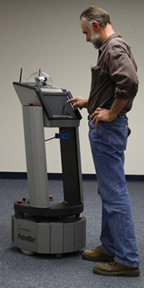
General-purpose autonomous robots are robots that typically mimic human behavior and are often build to be physically similar to humans as well. This type of robot is therefore also often called a humanoid robot. General-purpose autonomous robots are not as flexible as people, but they often can navigate independently in known spaces. Like computers, general-purpose robots can link with software and accessories that increase their usefulness. They may recognize people or objects, talk, monitor environmental quality, pick up supplies and perform other useful tasks. General-purpose robots may perform a variety of tasks simultaneously or they may take on different roles at different times of day.
Purpose-build robots
In 2006, there were an estimated 3,540,000 service robots in use, and an estimated 950,000 industrial robots. [35] A different estimate counted more than one million robots in operation worldwide in the first half of 2008, with roughly half in Asia, 32% in Europe, 16% in North America, 1% in Australasia and 1% in Africa.[36] Industrial and service robots can be placed into roughly two classifications based on the type of job they do. The first category includes tasks which a robot can do with greater productivity, accuracy, or endurance than humans; the second category consists of dirty, dangerous or dull jobs which humans find undesirable.
For increased productivity, accuracy, and endurance
Many factory jobs are now performed by robots. This has led to cheaper mass-produced goods, including automobiles and electronics. Stationary manipulators used in factories have become the largest market for robots.

Some examples of factory robots:
- Car production: Over the last three decades automobile factories have become dominated by robots. A typical factory contains hundreds of industrial robots working on fully automated production lines, with one robot for every ten human workers. On an automated production line, a vehicle chassis on a conveyor is welded, glued, painted and finally assembled at a sequence of robot stations.
- Packaging: Industrial robots are also used extensively for palletizing and packaging of manufactured goods, for example for rapidly taking drink cartons from the end of a conveyor belt and placing them into boxes, or for loading and unloading machining centers.
- Electronics: Mass-produced printed circuit boards (PCBs) are almost exclusively manufactured by pick-and-place robots, typically with SCARA manipulators, which remove tiny electronic components from strips or trays, and place them on to PCBs with great accuracy.[37] Such robots can place hundreds of thousands of components per hour, far out-performing a human in speed, accuracy, and reliability.[38]
- Automated guided vehicles (AGVs): Mobile robots, following markers or wires in the floor, or using vision[39] or lasers, are used to transport goods around large facilities, such as warehouses, container ports, or hospitals.[40]
- Early AGV-Style Robots were limited to tasks that could be accurately defined and had to be performed the same way every time. Very little feedback or intelligence was required, and the robots needed only the most basic exteroceptors (sensors). The limitations of these AGVs are that their paths are not easily altered and they cannot alter their paths if obstacles block them. If one AGV breaks down, it may stop the entire operation.
- Interim AGV-Technologies developed that deploy triangulation from beacons or bar code grids for scanning on the floor or ceiling. In most factories, triangulation systems tend to require moderate to high maintenance, such as daily cleaning of all beacons or bar codes. Also, if a tall pallet or large vehicle blocks beacons or a bar code is marred, AGVs may become lost. Often such AGVs are designed to be used in human-free environments.
- Newer AGVs such as the Speci-Minder,[41] ADAM, [42] Tug[43] and PatrolBot Gofer[44] are designed for people-friendly workspaces. They navigate by recognizing natural features. 3D scanners or other means of sensing the environment in two or three dimensions help to eliminate cumulative errors in dead-reckoning calculations of the AGV's current position. Some AGVs can create maps of their environment using scanning lasers with simultaneous localization and mapping (SLAM) and use those maps to navigate in real time with other path planning and obstacle avoidance algorithms. They are able to operate in complex environments and perform non-repetitive and non-sequential tasks such as transporting photomasks in a semiconductor lab, specimens in hospitals and goods in warehouses. For dynamic areas, such as warehouses full of pallets, AGVs require additional strategies. Only a few vision-augmented systems currently claim to be able to navigate reliably in such environments.
For dirty, dangerous, dull or inaccessible tasks

There are many jobs which humans would rather leave to robots. The job may be boring, such as domestic cleaning, or dangerous, such as exploring inside a volcano.[45] Other jobs are physically inaccessible, such as exploring another planet,[46] cleaning the inside of a long pipe, or performing laparoscopic surgery.[47]
- Telerobots: When a human cannot be present on site to perform a job because it is dangerous, far away, or inaccessible, teleoperated robots, or telerobots are used. Rather than following a predetermined sequence of movements, a telerobot is controlled from a distance by a human operator. The robot may be in another room or another country, or may be on a very different scale to the operator. For instance, a laparoscopic surgery robot allows the surgeon to work inside a human patient on a relatively small scale compared to open surgery, significantly shortening recovery time.[47] Several authors have been using a device called the Longpen to sign books remotely.[48] Teleoperated robot aircraft, like the Predator Unmanned Aerial Vehicle, are increasingly being used by the military. These pilotless drones can search terrain and fire on targets.[49][50] Hundreds of robots such as iRobot's Packbot and the Foster-Miller TALON are being used in Iraq and Afghanistan by the U.S. military to defuse roadside bombs or Improvised Explosive Devices (IEDs) in an activity known as explosive ordnance disposal (EOD).[51]
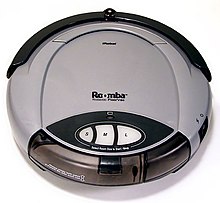
- Dedicated autonomous robots: As prices fall and robots become smarter and more autonomous, simple robots dedicated to a single task work in over a million homes. They are taking on simple but unwanted jobs, such as floor cleaning and lawn mowing. In many developed countries, such as Japan, the average age of the population is increasing, meaning that there are more elderly people to care for and fewer people available to care for them.[52][53] Researchers are working to create robots to help care for seniors.
Types of robots
Several types of robots exist:
- Soft Robots: Robots with silicone bodies and flexible actuators (air muscles, electroactive polymers, and ferrofluids), controlled using fuzzy logic and neural networks, look and feel different from robots with rigid skeletons, and are capable of different behaviors.[54]

- Swarm robots: Inspired by colonies of insects such as ants and bees, researchers are modeling the behavior of swarms of thousands of tiny robots which together perform a useful task, such as finding something hidden, cleaning, or spying. Each robot is quite simple, but the emergent behavior of the swarm is more complex. The whole set of robots can be considered as one single distributed system, in the same way an ant colony can be considered a superorganism, exhibiting swarm intelligence. The largest swarms so far created include the iRobot swarm, the SRI/MobileRobots CentiBots project [55] and the Open-source Micro-robotic Project swarm, which are being used to research collective behaviors.[56][57] Swarms are also more resistant to failure. Whereas one large robot may fail and ruin a mission, a swarm can continue even if several robots fail. This could make them attractive for space exploration missions, where failure can be extremely costly.[58]
- Haptic interface robots: Robotics also has application in the design of virtual reality interfaces. Specialized robots are in widespread use in the haptic research community. These robots, called "haptic interfaces" allow touch-enabled user interaction with real and virtual environments. Robotic forces allow simulating the mechanical properties of "virtual" objects, which users can experience through their sense of touch.[59]
Potential problems
Fears and concerns about robots have been repeatedly expressed in a wide range of books and films. A common theme is the development of a master race of conscious and highly intelligent robots, motivated to take over or destroy the human race. (See The Terminator, Runaway, Blade Runner, Robocop, the Daleks in Doctor Who, the Replicators in Stargate, the Cylons in Battlestar Galactica, The Matrix, and I, Robot.) Some fictional robots are programmed to kill and destroy; others gain superhuman intelligence and abilities by upgrading their own software and hardware. Examples of popular media where the robot becomes evil are 2001: A Space Odyssey, Red Planet (film), ... Another common theme is the reaction, sometimes called the "uncanny valley", of unease and even revulsion at the sight of robots that mimic humans too closely.[60] Frankenstein (1818), often called the first science fiction novel, has become synonymous with the theme of a robot or monster advancing beyond its creator.
Manuel De Landa has noted that "smart missiles" and autonomous bombs equipped with artificial perception can be considered robots, and they make some of their decisions autonomously. He believes this represents an important and dangerous trend in which humans are handing over important decisions to machines.[61]
Marauding robots may have entertainment value, but unsafe use of robots constitutes an actual danger. A heavy industrial robot with powerful actuators and unpredictably complex behavior can cause harm, for instance by stepping on a human's foot or falling on a human. Most industrial robots operate inside a security fence which separates them from human workers, but not all. The first fatality involving a robot was Robert Williams, who was struck by a robotic arm at a casting plant in Flat Rock, Michigan on January 25, 1979. [62] The second was 37-year-old Kenji Urada, a Japanese factory worker, in 1981. Urada was performing routine maintenance on the robot, but neglected to shut it down properly, and was accidentally pushed into a grinding machine.[63]
Literature
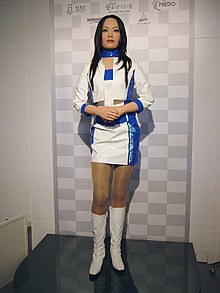
Robotic characters, androids (artificial men) or gynoids (artificial women), and cyborgs (also "bionic men", or humans with significant mechanical enhancements) have become a staple of science fiction.
The first reference in Western literature to mechanical servants appears in Homer's Iliad. In Book XVIII, Hephaestus, god of fire, creates new armor for the hero Achilles, assisted by robots.[64] According to the Rieu translation, "Golden maidservants hastened to help their master. They looked like real women and could not only speak and use their limbs but were endowed with intelligence and trained in handwork by the immortal gods." Of course, the words "robot" or "android" are not used to describe them, but they are nevertheless mechanical devices human in appearance.
The most prolific author of stories about robots was Isaac Asimov (1920–1992), who placed robots and their interaction with society at the center of many of his works.[65][66] Asimov carefully considered the problem of the ideal set of instructions robots might be given in order to lower the risk to humans, and arrived at his Three Laws of Robotics: a robot may not injure a human being or, through inaction, allow a human being to come to harm; a robot must obey orders given to it by human beings, except where such orders would conflict with the First Law; and a robot must protect its own existence as long as such protection does not conflict with the First or Second Law.[67] These were introduced in his 1942 short story "Runaround", although foreshadowed in a few earlier stories. Later, Asimov added the Zeroth Law: "A robot may not harm humanity, or, by inaction, allow humanity to come to harm"; the rest of the laws are modified sequentially to acknowledge this.
According to the Oxford English Dictionary, the first passage in Asimov's short story "Liar!" (1941) that mentions the First Law is the earliest recorded use of the word robotics. Asimov was not initially aware of this; he assumed the word already existed by analogy with mechanics, hydraulics, and other similar terms denoting branches of applied knowledge.[68]
See also
- Main list: Topic outline of robotics
For classes and types of robots see Category:Robots.
Notes and references
- ^ "Telecom glossary "bot"". Alliance for Telecommunications Solutions. 2001-02-28. Archived from the original on 2008-07-14. Retrieved 2007-09-05.
{{cite web}}:|archive-date=/|archive-url=timestamp mismatch; 2007-02-02 suggested (help) - ^ "Robotics: About the Exhibition". The Tech Museum of Innovation. Retrieved 2008-09-15.
- ^ "Your View: How would you define a robot?". CBC News. 2007-07-16. Retrieved 2007-09-05.
- ^ "Real Robots on the Web". NASA Space Telerobotics Program. 1999-10-15. Retrieved 2007-09-06.
- ^ "The Grand Piano Series: The History of The Robot". Nimbus Records. Retrieved 2007-09-08.
- ^ Marc Perton (2005-07-29). "Roboraptor review - this one has teeth (in the discussion below, several people talk about RoboRaptor as being a real robot". Engadget. Retrieved 2008-08-07.
- ^ "Definition of a robot" (PDF). Dansk Robot Forening. Archived from the original (PDF) on 2008-07-15. Retrieved 2007-09-10.
{{cite web}}:|archive-date=/|archive-url=timestamp mismatch; 2007-06-28 suggested (help) - ^ "Robotics-related Standards Sites". European Robotics Research Network. Retrieved 2008-07-15.
- ^ Lee, Dai Gil (2005). Axiomatic Design and Fabrication of Composite Structures. Oxford University Press. ISBN 0195178777. Retrieved 2007-10-22.
- ^ Polk, Igor (2005-11-16). "RoboNexus 2005 robot exhibition virtual tour". Robonexus Exhibition 2005. Retrieved 2007-09-10.
- ^ Harris, Tom. "How Robots Work". How Stuff Works. Retrieved 2007-09-10.
- ^ "Robot (technology)". Encyclopaedia Britannica Online. Retrieved 2008-08-04.
- ^ "Robot". Merriam-Webster Dictionary. Retrieved 2008-08-04.
- ^ a b Zunt, Dominik. "Who did actually invent the word "robot" and what does it mean?". The Karel Čapek website. Retrieved 2007-09-11.
- ^ Including Slovak, Ukrainian, Russian and Polish. The origin of the word is the Old Church Slavonic rabota "servitude" ("work" in contemporary Bulgarian and Russian), which in turn comes from the Indo-European root *orbh-.
- ^ "Čapek's R.U.R." Karelcapek.net. Retrieved 2008-07-15.
- ^ Robot is cognate with the German word Arbeiter (worker). In Hungary, the robot was a feudal service, similar to corvee which was rendered to local magnates by peasants every year. "The Dynasties recover power". Retrieved 2008-06-25.
- ^ Deborah Levine Gera (2003). Ancient Greek Ideas on Speech, Language, and Civilization. Oxford University Press. ISBN 978-0199256167.
- ^ O'Connor, J.J. and E.F. Robertson. "Heron biography". The MacTutor History of Mathematics archive. Retrieved 2008-09-05.
{{cite web}}: Cite has empty unknown parameter:|1=(help) - ^ "Earliest Clocks". A Walk Through Time. NIST Physics Laboratory. Retrieved 2008-08-11.
- ^ "Leonardo da Vinci's Robots". Leonardo3.net. Retrieved 2008-09-25.
- ^ Wood, Gabby. "Living Dolls: A Magical History Of The Quest For Mechanical Life", The Guardian, 2002-02-16.
- ^ N. Hornyak, Timothy (2006). Loving the Machine: The Art and Science of Japanese Robots. New York: Kodansha International. ISBN 4-7700-3012-6.
{{cite book}}: Cite has empty unknown parameter:|coauthors=(help) - ^ Cheney, Margaret (1989). Tesla, man out of time. New York: Dorset Press. ISBN 0-88029-419-1.
{{cite book}}: Cite has empty unknown parameter:|coauthors=(help) - ^ US 613809
- ^ "Tesla - Master of Lightning". PBS.org. Retrieved 2008-09-24.
- ^ "Robot Dreams : The Strange Tale Of A Man's Quest To Rebuild His Mechanical Childhood Friend". The Cleveland Free Times. Retrieved 2008-09-25.
- ^ Scott Schaut (2006). Robots of Westinghouse: 1924-Today. Mansfield Memorial Museum.
- ^ "The Grey Walter Online Archive". Retrieved 2008-09-25.
{{cite web}}: Unknown parameter|auther=ignored (|author=suggested) (help) - ^ "Robot Hall of Fame - Unimate". Carnegie Mellon University. Retrieved 2008-08-28.
- ^ "Imitation of Life: A History of the First Robots". Retrieved 2008-09-25.
- ^ Waurzyniak, Patrick (2006-07). "Masters of Manufacturing: Joseph F. Engelberger". Society of Manufacturing Engineers. 137 (1). Retrieved 2008-09-25.
{{cite journal}}: Check date values in:|date=(help)CS1 maint: date and year (link) - ^ "Company History". Fuji Yusoki Kogyo Co. Retrieved 2008-09-12.
- ^ "KUKA Industrial Robot FAMULUS". Retrieved 2008-01-10.
- ^ http://blogs.spectrum.ieee.org/automaton/2008/03/21/10_stats_you_should_know_about_robots.html
- ^ "Robots Today and Tomorrow: IFR Presents the 2007 World Robotics Statistics Survey". World Robotics. 2007-10-29. Retrieved 2008-09-25.
- ^ "Contact Systems Pick and Place robots". Contact Systems. Retrieved 2008-09-21.
- ^ "SMT pick-and-place equipment". Assembleon. Retrieved 2008-09-21.
- ^ "Smart Caddy". Seegrid. Retrieved 2007-09-13.
- ^ "The Basics of Automated Guided Vehicles". Savant Automation, AGV Systems. Retrieved 2007-09-13.
- ^ "SpeciMinder". CSS Robotics. Retrieved 2008-09-25.
- ^ "ADAM robot". RMT Robotics. Retrieved 2008-09-25.
- ^ "Can Do". Aethon. Retrieved 2008-09-25.
- ^ "Delivery Robots & AGVs". Mobile Robots. Retrieved 2008-09-25.
- ^ "Dante II, list of published papers". The Robotics Institute of Carnegie Mellon University. Retrieved 2007-09-16.
- ^ "Mars Pathfinder Mission: Rover Sojourner". NASA. 1997-07-08. Retrieved 2007-09-19.
- ^ a b "Robot assisted surgery: da Vinci Surgical System". Brown University Division of Biology and Medicine. Retrieved 2007-09-19.
- ^ "Celebrities set to reach for Atwood's LongPen". cbc.ca. Retrieved 2008-09-21.
- ^ Graham, Stephen (2006-06-12). "America's robot army". New Statesman. Retrieved 2007-09-24.
- ^ "Battlefield Robots: to Iraq, and Beyond". Defense Industry Daily. 2005-06-20. Retrieved 2007-09-24.
- ^ Shachtman, Noah (2005-11). "The Baghdad Bomb Squad". Wired Magazine. Retrieved 2007-09-14.
{{cite web}}: Check date values in:|date=(help) - ^ Jeavans, Christine (2004-11-29). "Welcome to the ageing future". BBC News. Retrieved 2007-09-26.
- ^ "Statistical Handbook of Japan: Chapter 2 Population". Statistics Bureau & Statistical Research and Training Institute. Retrieved 2007-09-26.
- ^ John Schwartz. "In the Lab: Robots That Slink and Squirm". nytimes.com. Retrieved 2008-09-22.
- ^ ((cite web|http://www.activrobots.com/RESEARCH/wheelchair.html%7Ctitle=SRI/MobileRobots Centibot project))
- ^ "Open-source micro-robotic project". Retrieved 2007-10-28.
- ^ "Swarm". iRobot Corporation. Retrieved 2007-10-28.
- ^ Knapp, Louise (2000-12-21). "Look, Up in the Sky: Robofly". Wired Magazine. Retrieved 2008-09-25.
- ^ "The Cutting Edge of Haptics". MIT Technology review. Retrieved 2008-09-25.
- ^ a b Ho, C. C. (2008). "Human emotion and the uncanny valley: A GLM, MDS, and ISOMAP analysis of robot video ratings" (PDF). Proceedings of the Third ACM/IEEE International Conference on Human-Robot Interaction. March 11-14. Amsterdam. Retrieved 2008-09-24.
{{cite journal}}: Unknown parameter|coauthors=ignored (|author=suggested) (help) - ^ *Manuel de Landa, War in the Age of Intelligent Machines, New York: Zone Books, 1991, 280 pages, Hardcover, ISBN 0-942299-76-0; Paperback, ISBN 0-942299-75-2.
- ^ Kiska, Tim (1983-08-11). "Death on the job: Jury awards $10 million to heirs of man killed by robot at auto plant". Philadelphia Inquirer. pp. A10. Retrieved 2007-09-11.
- ^ "Trust me, I'm a robot". The Economist. 2006-06-08. Retrieved 2007-04-30.
- ^ "Comic Potential : Q&A with Director Stephen Cole" (html). Cornell University. Retrieved 2007-11-21.
- ^ He wrote "over 460 books as well as thousands of articles and reviews", and was the "third most prolific writer of all time [and] one of the founding fathers of modern science fiction". White, Michael (2005). Isaac Asimov: a life of the grand master of science fiction. Carroll & Graf. p. 1-2. ISBN 0786715189.
- ^ R. Clarke. "Asimov's Laws of Robotics - Implications for Information Technology". Australian National University/IEEE. Retrieved 2008-09-25.
- ^ Seiler, Edward (2008-06-27). "Isaac Asimov FAQ" (HTML). Isaac Asimov Home Page. Retrieved 2008-09-24.
{{cite web}}: Unknown parameter|coauthors=ignored (|author=suggested) (help) - ^ White, Michael (2005). Isaac Asimov: A Life of the Grand Master of Science Fiction. Carroll & Graf. p. 56. ISBN 0-7867-1518-9.
Further reading
- Cheney, Margaret [1989:123] (1981). Tesla, Man Out of Time. Dorset Press. New York. ISBN 0-88029-419-1
- Craig, J.J. (2005). Introduction to Robotics. Pearson Prentice Hall. Upper Saddle River, NJ.
- Needham, Joseph (1986). Science and Civilization in China: Volume 2. Taipei: Caves Books Ltd.
- Sotheby's New York. The Tin Toy Robot Collection of Matt Wyse, (1996)
- Tsai, L. W. (1999). Robot Analysis. Wiley. New York.
- DeLanda, Manuel. War in the Age of Intelligent Machines. 1991. Swerve. New York.
External links
- Encyclopaedias
- Hobbyist tutorials
- Ikalogic – tutorials, active discussion board, most material is copyleft
- SocietyOfRobots – tutorials, active discussion board
- News sites
- Robots.net – Daily news about robots, robotics, and AI
- Other links
- Giant list of known robots
- IFR.org picture gallery – Pictures and classification of industrial robots. The larger site is a trade group with many possibly useful links.
- Template:Dmoz
- Robotics Research Papers at DMOZ
- Human Machine Integration Laboratory at Arizona State University
- Research societies
